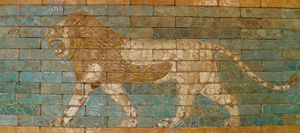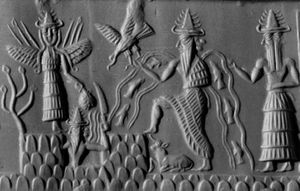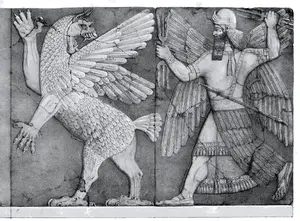Why Were there Multiple Ancient Mesopotamian Creation Myths
The idea of creation is a complex concept that was approached differently by various peoples in the ancient world. The ancient Egyptians had three primary cosmogonies that corresponded with three of their most important deities and although each of these creation myths offered different cosmologies, they were not mutually exclusive. In a similar manner, the Egyptians’ contemporaries in Mesopotamia also had multiple creation myths, but they arrived at their multitude of cosmogonies for different reasons.
Although Egypt has historically been divided by north and south (Lower and Upper Egypt), it was essentially a monocultural society in ancient times: the people spoke the same language and followed the same religion. Mesopotamia, though, was quite a different situation. The history of ancient Mesopotamia is one of various ethnic groups and city-states battling for hegemony over sub-regions and at times, the entire region of Mesopotamia. The Sumerians were followed by Semitic speaking groups from Babylonia, who were in turn conquered by the Assyrians, who then fell to the Semitic speaking Chaldeans. Although all of these groups followed essentially the same religion, certain gods and goddesses took precedent in particular cities and with specific ethnic groups, which resulted in multiple Mesopotamian creation myths.
The Nature of Ancient Mesopotamian Society
In order to understand why the ancient Mesopotamians formulated multiple creation myths, one needs to look no further than the politically fragmented nature of their society. As mentioned above, Mesopotamia was a checkerboard of different ethnic groups and independent city-state kingdoms, with each city-state having a prominent god or goddess. [1] As the cult’s of these city deities developed, so too did unique cosmogonies that placed the specific god or goddess at the center.
By the late third millennium BC, several regional powers emerged in Mesopotamia that were able to gain control over large parts of the region, most notably the following: Akkad (c. 2334-2054 BC), the Ur III Dynasty (c. 2112-2004 BC), and the First Dynasty of Babylon or Amorite Dynasty (c. 1894-1595 BC). With the regional political hegemony that these dynasties were able to impose, other cultural ideas also became standardized. Akkadian became the lingua franca of the disparate ethnic groups of the region and a pantheon of deities also emerged that was based on Sumerian theology, but heavily augmented by Semitic influences. [2] Still, despite the tendency toward uniformity, different theological traditions and myths existed simultaneously, including creation myths.
The Atrahasis Myth
One of the most studied Mesopotamian creation myths is named after one of the gods in the story, Atrahasis, although much of the action centers around another divine protagonist – Enki/Ea. The Atrahsis myth is mainly preserved in fragments of Old Babylonian texts, along with some fragments of Middle Babylonian and Assyrian versions. The best preserved texts were discovered in the well-stocked library of the Assyrian King Ashurbanipal (ruled 668-627), who despite his often brutal rule and war tactics was a patron of Mesopotamian literature. [3] The myth has been studied extensively in the West because a deluge similar to the biblical flood plays a role, but that is only toward the end of the story. Besides the flood, the Atrahasis myth is important because it depicts creation as an ongoing, cyclical process and the antediluvian earth in an era when there was only a fine line separating humans and gods. [4] The myth begins with a conflict between the gods, where one class essentially works for the other. In order to get out of the toiling labor, the mischievous yet clever Enki/Ea, along with the mother goddess Nintu, created humanity from a combination of the blood of the gods and clay.
“Thou art the mother-womb. The one who creates mankind. Create, then, Lullu and let him bear the yoke! The work of god mand shall bear!” Nintu opened her mouth, Saying to the great gods: “With me is the doing of (this) not suitable; With Enki is (this) work (proper)! He purified everything, Let him give me the clay, then I will do (it)!” Enki opened his mouth, Saying to the great gods: “On the first of the month, the seventh and fifteenth days, I will prepare a purification, a bath. Let one god be slain, And let the gods be purified by immersion In his flesh and blood. Let Nintu mix clay, Let them together be smeared with clay. Unto eternity let us hear the drum.” [5]
The myth then goes on to explain how the god Enlil would destroy humanity after 1,200 for being too populous and noisy, ruining his rest. The process happened for a total of three times.
“The land became wide, the peop[le became nu]merous, The land bellowed like wild oxen. [Enlil] heard their clamor (An) said to the great gods: ‘Oppressive has become the clamor of mankind. By their uproar they prevent sleep.’” [6]
Finally, Enlil could not take it anymore so he decided to wipe out humanity with a world-wide deluge. Enki, though, was able to save a remnant of humanity by telling them to build a ship.
“Destroy the house, build a ship, Renounce (worldly) goods, Keep the soul alive! The ship that thou shalt build.” [7]
The similarity to the biblical flood is at first obvious, but Moran pointed out that resemblances are mainly superficial. He noted that unlike the biblical flood, there was no mention of “sin” in the Atrahasis myth, and there are plenty of Akkadian words that describe sin. [8] Moran ultimately argued that the Mesopotamian deluge was just the final act in the long process of creation and that the underlying theme was the order of the gods versus the disorder of the humans. [9]
The Enuma Elish Myth
In the fourteen century, another creation myth rose to prominence as Babylon and its patron god, Marduk, became the center of cultural and political activity in Mesopotamia. This myth is known as the Enuma Elish, or “When on High” myth for the first words in the epic. The myth was recited orally at the annual New Year festival in Babylon in praise of Marduk. [10]
According to the myth, the dragon goddess Tiamat emerged from the primeval waters with her consort Apsu. Marduk and a new generation of deities then were born from their union.
“When on high the heaven had not been named, Firm ground below had not been called by name, Naught but primordial Apsu, their begetter, (And) Mummu-Tiamat, she who born them all.” [11]
Similar to the Atrahasis myth, creation is a long process marked by cycles. The generation of younger gods later killed Apsu and prepared for a war with Tiamat and her new consort, Kingsu. Marduk then created the first weapons of war.
“He constructed a bow, marked it as his weapon, Attached thereto the arrow, fixed its bow-cord. He raised the mace, made his right hand grasp it; Bow and quiver he hung at his side. In front of him he set the lightning.” [12]
Marduk wasted little time using his newly crafted weapons, slaying Tiamat and Kingsu in short order. A third creation then commenced when Marduk used Tiamat’s body to create the heavens and the earth.
“Then the lord paused to view her dead body, That he might divide the monster and do artful works. He split her like a shellfish into two parts: Half of her set up and ceiled it as sky, Pulled down the bar and posted guards. He bade them to allow not her waters to escape.” [13]
Marduk then used Kingsu’s body to fashion the first humans.
“When Marduk hears the words of the gods, His heart prompts (him) to fashion artful works. Opening his mouth, he addresses Ea To impart the plan he had conceived in his heart: ‘Blood I will mass and cause bones to be. I will establish a savage, “man” shall be his name. Verily, savage-man I will create. He shall be charged with the service of the gods That they might be at ease!’” [14]
Both the Atrahsis myth and Enuma Elish share the idea that man was created to serve the gods and that creation was a long, cyclical process. The form and the deities represented in the myths were different, although deities were often interchangeable in Mesopotamian theology. For instance, the Assyrians replaced their primary god Ashur for Marduk in their version of the Enuma Elish myth.
Local Mesopotamian Creation Myths
As stated earlier, all Mesopotamian cosmogonies originated as local myths but grew with the importance of particular dynasties. Not all local cosmogonies were so lucky, with many being forgotten, although some of the more obscure ones did persist. A late Babylonian text from the otherwise inconsequential city of Dunnu relates how creation began with a divine pair – Hain and Earth – and then quickly descended into incest and patricide.
"[. . .] in the begin[ing . . .] [. . .] and [. . .] They [. . .] . . . their plough. [With the c]ut of their plough they created Sea. [Second]ly, by themselves they gave birth to Amaka[ndu]. [Thi]rdly, they built the two Pillars of Dunnu. [Ha]in bestowed the lordship in Dunnu on himself. [Earth] turned her attention to Amakandu, her son, She said to him, ‘Come, I will make love to you!’ Ama[kandu’ married Earth, his mother; He killed Hian, his [father, and] Laid [him] to rest in Dunnu, the city which he loved.” Then Amakandu [too]k the lordship of his father [and] [Ma]rried Se, his sister." [15]
Conclusion
Mesopotamian creation myths reflected the nature of ancient Mesopotamian civilization. As Mesopotamian civilization developed from a collection of disparate city-states and ethnic groups, multiple cosmogonies also developed and existed simultaneously. Eventually, two creation myths came to dominate the Mesopotamian religious landscape, but evidence shows that other cosmogonies continued to be recognized locally.
References
- ↑ Mieroop, Marc van de. A History of the Ancient Near East: ca. 3000-323 BC. Second Edition. (London: Blackwell, 2007), p. 45
- ↑ Mieroop, pgs. 46-47
- ↑ Moran, William L. “The Babylonian Story of the Flood.” Biblica. 52 (1971) p. 51
- ↑ Soden, Wolfram von. The Ancient Orient: An Introduction to the Study of the Ancient Near East. Translated by Donald G. Schley. (Grand Rapids, Michigan: William B. Eerdmans, 1994), p. 211
- ↑ Pritchard, James B, ed. Ancient Near Eastern Texts Relating to the Old Testament. Third Edition. (Princeton, New Jersey: Princeton University Press, 1992), pgs. 99-100
- ↑ Pritchard, p. 104
- ↑ Pritchard, p. 105
- ↑ Moran, p. 56
- ↑ Moran, pgs. 58-59
- ↑ Soden, pgs. 212-3
- ↑ Pritchard, p. 61
- ↑ Pritchard, p. 66
- ↑ Pritchard, p. 67
- ↑ Pritchard, p. 68
- ↑ Pritchard, pgs. 517-8


